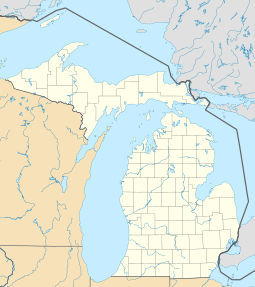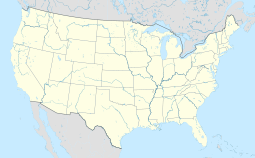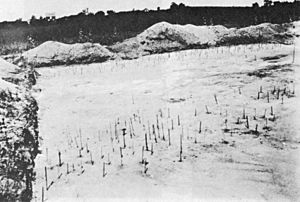Younge Site facts for kids
|
Younge Site (20LP3)
|
|

Younge Site, c. 1936
|
|
| Location | Goodland Township, Michigan |
|---|---|
| Area | 3 acres |
| NRHP reference No. | 76002161 |
Quick facts for kids Significant dates |
|
| Added to NRHP | October 29, 1976 |
The Younge Site is an amazing archeological site in Goodland Township, Lapeer County, Michigan. It's a place where scientists study the past. This site dates back to the Prehistoric Late Woodland time. It became a special Michigan State Historic Site on October 29, 1971. Later, it was added to the National Register of Historic Places on October 29, 1976.
Contents
What is the Younge Site Like?
The Younge Site is on a flat area about a mile wide. It's close to Imlay Channel, which is a small river. This channel flows into Mill Creek, then into the Black River, and finally into Lake Huron. The site covers about three acres. It holds the remains of two old fenced-in areas.
How Archeologists Explored the Younge Site
Archeology is the study of human history through digging up old things.
Early Digs: 1934-1935
The first small dig at the Younge Site happened in 1934. W. B. Hinsdale led this first look. It showed that the site was very important. Because of this, more detailed digs took place the next year. Emerson Greenman from the University of Michigan led these bigger excavations.
Later Studies: Pottery and Time
Almost 30 years later, a scientist named James Fitting studied the pottery found at Younge. He used it to create a timeline for the Late Woodland culture. This timeline helped understand the history of southeast Michigan.
Discoveries from the 1934-1935 Digs
Archeologists found the remains of two fenced areas. These fences were made from poles stuck into the ground. One fence was about 585 feet long and 25–30 feet wide. The second was 252 feet long and 25 to 30 feet wide. Inside these areas, they found human remains, storage pits, and fireplaces. They also found old plant and animal parts. Many prehistoric artifacts from the Late Woodland period were also uncovered.
Features: Pits and Fireplaces
The archeologists dug up 88 pits and several fireplaces. Three of these pits contained the remains of maize, also known as corn. This shows that people at the site grew crops.
Burials: What Archeologists Found
Thirty-seven burials were found at the site. Some of these burials had special items placed with them. These items are called grave goods. Some skeletons also showed changes that might have been part of their culture.
- One burial had a tobacco pipe.
- Two burials had mussel shells.
- One burial had red ochre, a natural earth pigment.
- One burial had a celt, which is a type of stone axe.
- Some skulls had small holes drilled into them. Others had circular pieces removed.
- Five skulls had clay in the face areas.
- Some leg bones were changed to help support the body. This might have been for a special ceremony. Early European settlers had heard about similar ceremonies.
The way the burials were placed suggests a ceremony. This ceremony might have been like the "Huron Feast of the Dead" of the Huron tribe. This ceremony was seen by early European settlers.
Animal Remains: What They Ate
Archeologists found bones from many animals in the pits and topsoil. They didn't count every piece. But the main animals found were beaver, marten, red fox, and muskrat. They also found bones from wild turkey, walleyed pike, and largemouth black bass. Several types of mussel shells were also present. These animal remains were likely food scraps. They were not made into tools.
Plant Remains: Evidence of Farming
Scientists did not collect all plant remains carefully. However, they found maize (corn) in three pits. This is important because it shows that people at the Younge Site practiced agriculture. They grew their own food.
Artifacts: Tools and Objects
Many different objects were found at the site. These artifacts help us understand how people lived.
- Pottery: About 1,500 pieces of broken pottery were found. These pieces are called sherds.
- Stone Tools: These included projectile points (like arrowheads), scrapers, and flakes. There were many small triangular points, which are thought to be arrow-tips. The use of the bow-and-arrow became much more common during the Late Woodland time. This might be because there was more conflict.
- Ground Stone Artifacts: These included pitted stones, stones for rubbing, a net-sinker (used to weigh down fishing nets), and a celt.
- Bone Tools: Only two pieces of worked bone were found. One was likely an awl (a pointed tool). The other was a chisel.
- Tobacco Pipes: Two whole pipes and 47 broken pieces were found.
Late Woodland Pottery: A Window into the Past
Pottery is very useful for archeologists. It's often found in large amounts. The way it was made and decorated can tell us about the time, place, and culture of the people.
No complete pottery pots were found at Younge. So, researchers studied the rim pieces and unique body pieces. All the pottery was made with grit (small stones) mixed in the clay. This is typical of Late Woodland pottery. Most pieces had a pattern made by pressing a cord-wrapped paddle onto the wet clay.
Almost all the pottery pieces had some kind of decoration. Several types of patterns were seen:
- Patterns made by pressing a two-ply cord.
- Patterns made by pressing a cord-wrapped stick.
- Designs scratched into the clay with a sharp tool.
- Small holes (punctates) in rows, forming a checkered pattern.
The Younge Tradition: A Long History
James Fitting created the idea of the Younge Tradition. This is also known as the Western Basin Tradition. It describes a long period of people living in southeast Michigan and the western Lake Erie area. This tradition might go back as far as 3000 B.C. and continue to about A.D. 1400.
The Late Woodland part of this tradition has different phases:
- Riviere Au Vase Phase (around A.D. 800-1000)
- Younge Phase (around A.D. 1000-1200)
- Springwells Phase (around A.D. 1200-1350)
- Wolf Phase (around A.D. 1350-1450)
The Younge Phase is named after the Younge Site. This is where pottery from this phase was first found.
Fitting sorted the Younge pottery into four main types. All these types are part of the Riviere Ware group. They all used grit to temper the clay.
- Vase Dentate: Seven pots of this type were found. They were large, round pots. They had cord-marked or fabric-wrapped surfaces. They were decorated with slanted or vertical marks along the rim. These marks were made with a special stamp or comb.
- Vase Tool-Impressed: Five pots of this type were found. They were similar to Vase Dentate. But they had more "castellations," which are bumps or points on the rim.
- Vase Corded: Eleven pots of this type were found. They were similar to the other Vase types. But they were longer, and their rims often had castellations.
- Macomb Linear: Eight pots of this type were found. These were long pots with narrow necks. Their rims were often castellated. They had designs like horizontal lines or triangles.
The pottery styles suggest that the Younge Site and the Riviere au Vase site are from similar times. The Riviere au Vase site also has an older type of pottery called Wayne Ware, which is not found at Younge. This means the Younge Site was used a little later than Riviere au Vase.
The Younge Phase is similar to other cultures in Canada and New York State. Some scientists think these groups were related. They might have spoken an Iroquoian language.
Why the Younge Site is Important
The Younge Site was one of the first places dug up in southeastern Michigan. It's a key site for understanding the Younge Tradition. Finding maize (corn) shows that the Late Woodland cultures in this area grew their own food. Also, the burials at the site teach us about the special customs people had for their dead during this time.




